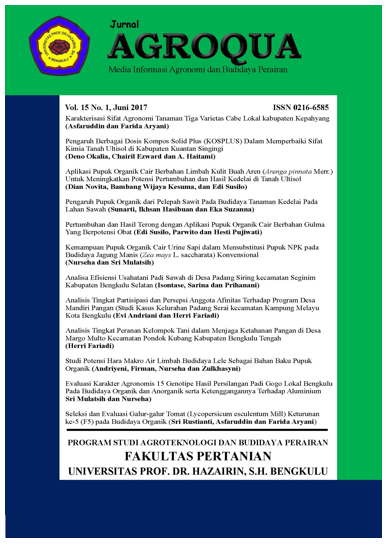UJI ALLELOPATI POTENSIAL TERHADAP PERKECAMBAHAN GULMA Echinochloa cruss-galli (L.) Beauv,
Keywords:
allelopaty, germination, weed, Echinochloa cruss-galli (L.) BeauvAbstract
This research aims to select the best of seven part of plants known to have potential allelopaty effect and to know their influences on germination of weed Echinochloa crus- gally. The research had been conducted in laboratory of Departement of Plantation, Bengkulu Province from February to March 2011. Seven plant species that potentially contain allelopaty are M0= Control; M1= Fermented coconut water; M2= Pithecellobium jiringa; M3= Eucalyptus; M4= Acasia mangium, M5= Imperata cylindrica, M6= Swietenia macrophylla M7= Jatropha curcas. The part of plants were taken for their extract are Imperata cylindrica rizome,. Eucalyptus, Acasia mangium and Jatropha curcas lives. Swietenia macrophylla extract made from its seed. Pithecellobium jiringa taken from outer skin skin of its fruit. Coconut’s water taken from the old coconut fruit. The design used was Completely Randomized Design with five replication. This study concluded that: (1) The treatment plant extracts tested had very significant effect on the germination of weed Echinochloa crus-gally; (2) extract treatment plant parts were tested suppressed weed germination Echinochloa crus-gally; (3) Allelopaty sources of different sources are fermented coconut water, Pithecellobium jiringa, Eucalyptus, Imperata cylindrica, Acacia mangium, Swietenia macrophylla, and Jatropha curcas had no significant effect on the inhibition of germination of weed E. crus-gally.
References
Downloads
Published
Issue
Section
License
Authors who publish with this journal agree to the following terms:
- Authors grant the journal right of first publication with the work simultaneously licensed under a Creative Commons Attribution 4.0 Internasional (CC BY 4.0) Licence that allows others to use and share the work with an acknowledgment of the work's authorship and initial publication in this journal.
- The author(s) still hold the copyright of his/her/their work and retain publishing rights without restrictions such as (but not limited to) patent right, lecture, book and reproduce the article for own purposes.
















